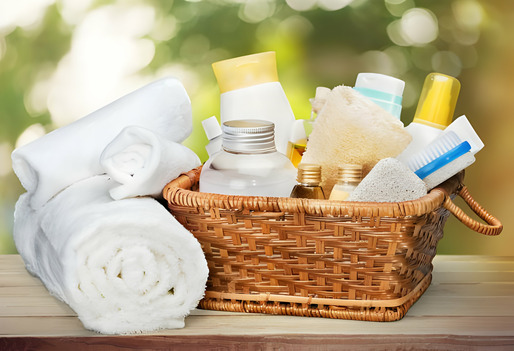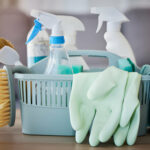
Cleaning is a daily ritual, but have you ever considered the impact your cleaning routine has on the environment? The art of green cleaning introduces a harmonious blend of cleanliness and sustainability. Green cleaning involves the use of products that are derived from natural, non-toxic ingredients. These substances pose minimal harm to the environment, promoting sustainability.
In this comprehensive guide, we will delve into the world of eco-friendly cleaning products, unraveling the secrets of maintaining a spotless home while minimizing our ecological footprint.
Here is our post on The Art of Eco-Friendly Dishwashing: Green Practices in the Kitchen
Benefits of Green Cleaning
- Reduces exposure to harmful chemicals for you and your family.
- Enhances indoor air quality, reducing respiratory issues.
- Lowers environmental impact, contributing to a healthier planet.
Common Harmful Ingredients in Traditional Cleaners
- Phthalates: Found in fragrances, linked to hormone disruption.
- Chlorine: Present in bleach, can lead to respiratory problems.
- Triclosan: An antimicrobial agent with environmental concerns.
How Green Cleaning Supports Sustainability
- Biodegradability: Eco-friendly products break down naturally.
- Reduced Packaging Waste: Many green cleaners use minimal, recyclable packaging.
- Cruelty-Free: Ethical testing practices contribute to a compassionate industry.
Dispelling Myths About Green Cleaning
Myth: Green products are less effective. Reality: Many are as effective as traditional cleaners.
Myth: They are more expensive. Reality: Long-term benefits often outweigh initial costs.
Essential Eco-Friendly Cleaning Products
All-Purpose Green Cleaners
Instead of multiple specialized products, opt for a versatile all-purpose cleaner. Look for those made from plant-based ingredients like vinegar, lemon, or baking soda.
Natural Disinfectants
Essential oils such as tea tree oil and eucalyptus have natural antibacterial properties. Mix them with water for a potent, eco-friendly disinfectant.
Eco-Friendly Laundry Detergents
Choose phosphate-free and biodegradable laundry detergents. They clean effectively without leaving harmful residues in water systems.
Reusable Cleaning Cloths
Swap disposable wipes for reusable cloths made from bamboo or organic cotton. They are washable, reducing waste and saving money in the long run.
Non-Toxic Drain Cleaners
Baking soda and vinegar can unclog drains effectively. Say goodbye to harsh chemical drain cleaners that harm both your pipes and the environment.
See also our post on The Art of Eco-Friendly Carpet Cleaning: Green Solutions for Stains and Odors
DIY Green Cleaning Recipes
Homemade All-Purpose Cleaner
Mix equal parts water and white vinegar, add a few drops of essential oil for fragrance. This concoction works wonders on various surfaces.
Natural Glass Cleaner
Combine water, rubbing alcohol, and cornstarch for streak-free windows. An eco-friendly alternative to commercial glass cleaners.
DIY Air Freshener
Simmer water with citrus peels, cinnamon, and cloves for a refreshing, natural fragrance. Ditch synthetic air fresheners with harmful chemicals.
Green Oven Cleaner
Baking soda and water make a powerful paste for oven cleaning. Say goodbye to fumes and toxic residues.
Wood Polish from Nature
Olive oil and lemon juice create a nourishing wood polish. Keep your furniture gleaming without resorting to chemical-laden polishes.
Sustainable Cleaning Tools
Eco-Friendly Scrub Brushes
Opt for brushes made from sustainable materials like bamboo or recycled plastic. They are durable and won’t contribute to plastic pollution.
Reusable Microfiber Cloths
These cloths are not only effective in cleaning but also reduce waste. Wash and reuse them for a greener, cost-effective alternative.
Biodegradable Trash Bags
Regular plastic bags take centuries to decompose. Choose biodegradable trash bags made from plant-based materials for a more sustainable option.
Green Mops and Brooms
Seek out mops with reusable and replaceable heads. Brooms made from natural materials like straw or recycled plastic contribute to sustainability.
Recyclable Cleaning Spray Bottles
Many eco-friendly brands offer cleaning products in bottles that can be easily recycled. Support brands committed to reducing plastic waste.
See also our post on The Art of Green Cleaning: Balancing Effectiveness and Sustainability
Choosing Responsible Brands
Researching Ethical Practices
Investigate a brand’s commitment to sustainability, cruelty-free practices, and ethical sourcing of ingredients.
Certifications to Look For
Seek products with certifications like USDA Organic, EcoLogo, or Cradle to Cradle. These certifications validate a product’s eco-friendly claims.
Packaging Considerations
Opt for brands that use minimal, recyclable, or biodegradable packaging. This reduces the environmental impact of your cleaning routine.
Supporting Local and Sustainable
Consider local brands that prioritize sustainability. Supporting them contributes to a more environmentally conscious community.
Community Reviews and Recommendations
Utilize online platforms to access reviews and recommendations from the community. Real experiences can guide you toward trustworthy eco-friendly products.
Challenges and Solutions in Green Cleaning
Initial Cost Concerns
While some eco-friendly products may seem expensive initially, consider the long-term benefits. Many last longer and provide value over time.
Availability of Green Products
As demand grows, more green cleaning options become available. Explore local and online markets for a wider selection.
DIY vs. Store-Bought
Balancing DIY recipes with store-bought products depends on convenience and personal preferences. Find the right mix that suits your lifestyle.
Educational Barriers
Lack of awareness is a challenge. Share information with friends and family to collectively make informed, eco-conscious choices.
Adapting to New Cleaning Habits
Transitioning to green cleaning may require adjusting habits. Be patient and gradually incorporate sustainable practices into your routine.
See also our post on 10 Benefits of Green Cleaning for Apartment Complexes
Conclusion
Embracing the art of green cleaning is more than just a fad; it is a commitment to a healthier home and planet. You can help create a cleaner, greener future by learning the principles, selecting eco-friendly products, and implementing sustainable practices. Even small changes to your cleaning routine add up to make a big difference to the environment. As we set out on this journey, let us keep in mind that the art of green cleaning is about more than just spotless surfaces—it is about creating a sustainable, eco-friendly lifestyle for future generations.







